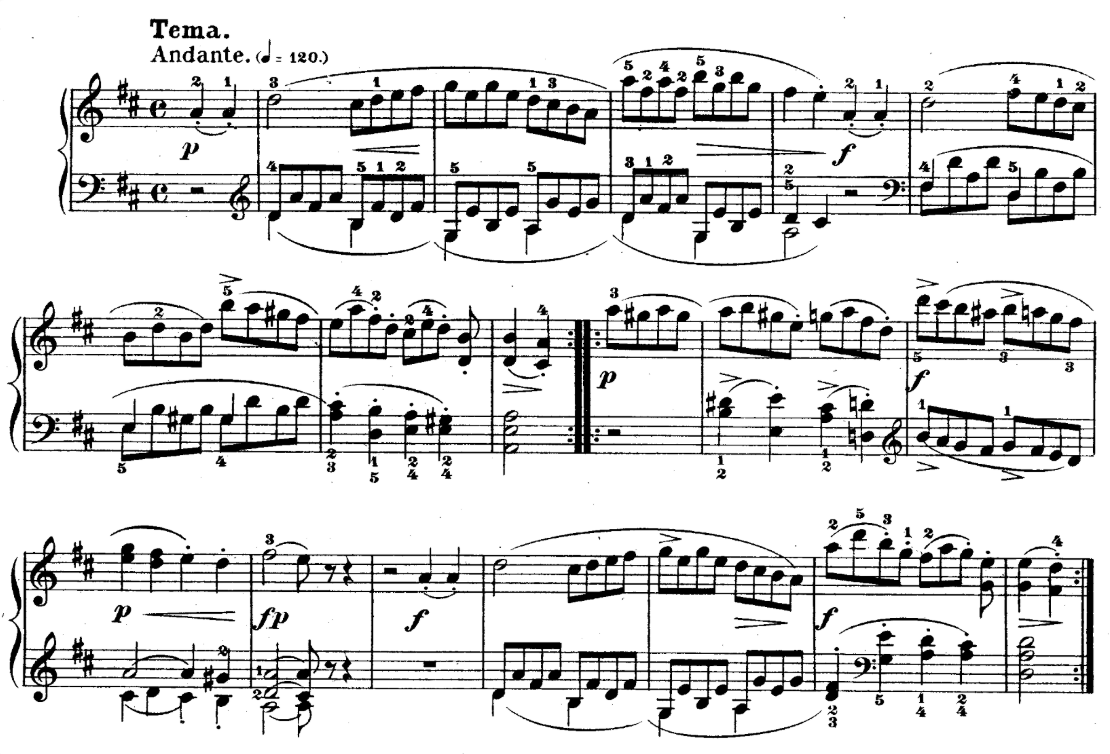4.6: Classical Theme Types - The Small Ternary
- Page ID
- 61970
Like the smaller sentence, period, and hybrid themes, the small ternary can act alone as the theme of a full-movement form. The small ternary is larger, however–constructed from themes just as the smaller theme types were constructed from phrases and sub-phrases. As a slightly larger structure, this theme type involves interesting questions about formal organization and perception–questions that stem from its historical pedigree among other things–that we will also find in the full-movement forms.
This theme type is normally expressed through three thematic functions: “exposition (A),” “contrasting middle (B),” and “recapitulation (A).”

THE SMALL TERNARY
###Three thematic functions The exposition and recapitulation are “tight-knit” functions usually expressed by one of the smaller theme types. Each ends with a cadence. Most commonly, a small-ternary’s exposition will end with a I:PAC, but the exposition may also modulate to a closely related key. In major-mode pieces, a typical modulation will yield an exposition ending with a V:PAC, while in the minor mode, the mediant (III:PAC) key area is more common.
A recapitulation follows the contrasting middle and is marked by a return of thematic material from the exposition. In the simplest examples, a recapitulation may simply copy the exposition. But more commonly, some changes are made, including expansions and contractions. Alterations are especially common–necessary, in fact–when the exposition cadences in a non-tonic key: Recapitulation’s invariably close with a I:PAC, and thus, if the exposition has modulated, the recapitulation must be altered to end in tonic.
Located between the exposition and recapitulation, the contrasting middle is a “loose” formal region that provides melodic and harmonic contrast. Because it is a looser region, it is not commonly expressed by a theme type. If anything, unpredictability is typical. Nonetheless, we can often characterize such passages in terms of “loosening devices” like fragmentation, sequence, and modulation. And as a means of providing harmonic contrast, contrasting middles tend to emphasize dominant harmony. To mark their end, provide contrast, and create anticipation for the return of tonic in the recapitulation, these sections invariably have dominant harmony at their close. This may be expressed as a I:HC, V:PAC, or in simpler cases, the entire contrasting middle may prolong dominant harmony through a “standing on the dominant.”
###An example

MOZART, PIANO SONATA IN D MAJOR, K. 284, "TEMA CON VARIAZIONE"
A prototypical example is given above–the “theme” of the variation movement closing Mozart’s Piano Sonata in D major, K. 284. Mozart’s exposition is a simple period whose second half modulates to the dominant, ending with a V:PAC. Following the repeat, the contrasting middle begins with a fonte sequence that leads to a fragmented, descending scalar passage that closes the section with a I:HC. (Note the motivic relationships to the exposition: the descending scale in m. 10 recalls the pickup to m. 7, and the fonte sets a melodic motive that resembles the first two beats of m. 7.) Finally, the recapitulation recalls the exposition. It presents only the contrasting phrase, however, altering it so that the theme ends with a I:PAC.
###Binary characteristics Mozart’s theme gives us an example of one of the most common characteristics of the small ternary: the repeat signs. Those repeat signs divide the form into two parts, and therein lies one of the most discussed (and perhaps, most controversial and confusing) features of this thematic type. Because on the largest scale the three parts of this theme are nested within two reprises, many music theorists prefer to label these passages as binaries. Since we have chosen to emphasize the functional characteristics of classical form, of which there are three in this passage, the ternary understanding is more appropriate here. Throughout the history of music, we also find examples without repeats (or with perhaps only one repeat), and those examples establish the repeat signs as a non-obligatory feature.
But rather than settling the question, sophisticated analysts tend to understand the ambiguity present here. As a common hedge, many music theorists label passages like Mozart’s (those with an exposition, contrasting middle, recapitulation, and repeat signs) as “rounded binaries.” The “rounded” description refers to the return of the exposition material at the form’s end, which has the effect of “rounding out” the structure.


